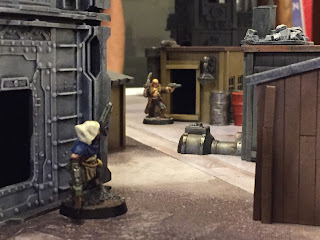Visions of Confluence: The Pokey Bits
Most games have rules of one kind or another to cover hazardous terrain, that type of terrain that impedes movement and/or causes damage. For me, this has typically been the more difficult to create, as there are only so many options out there. Pools of Lava or some other caustic substance, holes or crevices, or barbed wire fences and sharp rocks. I’ve never really like examples I’ve seen of any of these, so up until now I’ve steered away from hazardous terrain on my boards.
For the Confluence project, however, I had a chance to try something new. Cactus patches. I’ve seen these done before many ways, but I wanted to apply the same mentality to creating hazardous terrain to the way I created the rest of my terrain. For my hazardous terrain, I chose Pegasus Hobbies Cactus models. These come in 2 different sets and if you pick them both up, you will have enough for all of the patches I’ve created as well as a large surplus for other terrain pieces or bases or what have you.
While I’ve seen these cacti used straight out of the box and they do work that way, I wanted to make sure they fit the rest of the tables and looked really good. To that end, I mounted clusters of cacti on thin plasticard bases taking care to make them as random and natural looking as possible. This worked well because cacti typically grow in clusters and clumps. I went on to add some of my usual fine mix of sand and then added some small stones and a few larger ones. In addition to the bases I made for the cacti, I made several more without cacti that I would use for other ground cover such as refuse, building material or smaller plant life.
Anyway, then it was time to paint the cacti. I decided to save some time and get a nice subtle look that I’d use my brand new Patriot 105 Extreme. I just recently received the airbrush, so I needed some practice in order to dial it in and the cacti would be the perfect opportunity.
 The Pegasus sets come with two varieties of cacti and I opted to keep the varieties together and to paint them differently. For the longer, thinner cacti (these are typically known as San Pedro Cactus) I opted for a deeper and more cool green color scheme. For them, I undercoated black and them basecoated with Vallejo Model Air Olive Drab. From there, I added a highlight of VMA Field Green and then did a final highlight with a 50/50 mix of Field Green and Pale Green. To make them really pop, I then airbrushed a thin wash of Secret Weapon Amethyst Wash. This settled into the depths of the cactus patches and really made them look good.
The Pegasus sets come with two varieties of cacti and I opted to keep the varieties together and to paint them differently. For the longer, thinner cacti (these are typically known as San Pedro Cactus) I opted for a deeper and more cool green color scheme. For them, I undercoated black and them basecoated with Vallejo Model Air Olive Drab. From there, I added a highlight of VMA Field Green and then did a final highlight with a 50/50 mix of Field Green and Pale Green. To make them really pop, I then airbrushed a thin wash of Secret Weapon Amethyst Wash. This settled into the depths of the cactus patches and really made them look good.Of course the other variety of cacti I had were the more traditional prickly pears. For these, I wanted something a little brighter and more green. I started then with a basecoat of VMA Medium Green and highlighted with Field Green and then Pale Green. To add just a bit of yellow and warmth, I also added a bit of Green Zinc Chromate to a final highlight. Again, I toned them down just a bit with an Amethyst wash, though I mixed this with Ruby to keep it warmer.
 Finally, I took out the brushes and basecoated the ground, first in black and then steadily highlighting up to the soil mix I’ve been using for the rest of the table.
Finally, I took out the brushes and basecoated the ground, first in black and then steadily highlighting up to the soil mix I’ve been using for the rest of the table.
bunch of victims to their pokey depths.
As always comment and critiques are welcome. Thanks for stopping by.
More to Come.
-Nick







They look great. I completely agree - hazardous terrain makes Malifaux games so much more entertaining. Teddies just love hugging enemy models and doing Peekaboo into cacti/lava.
ReplyDeleteUgh...Teddy...Don't remind me....Thanks!
Delete